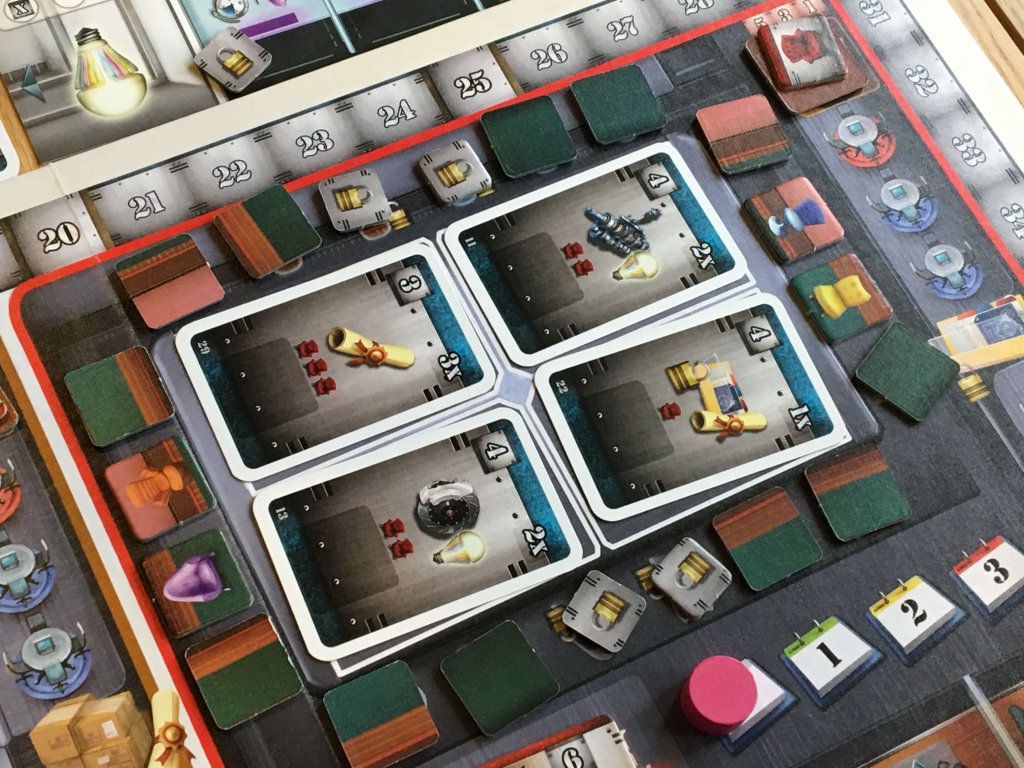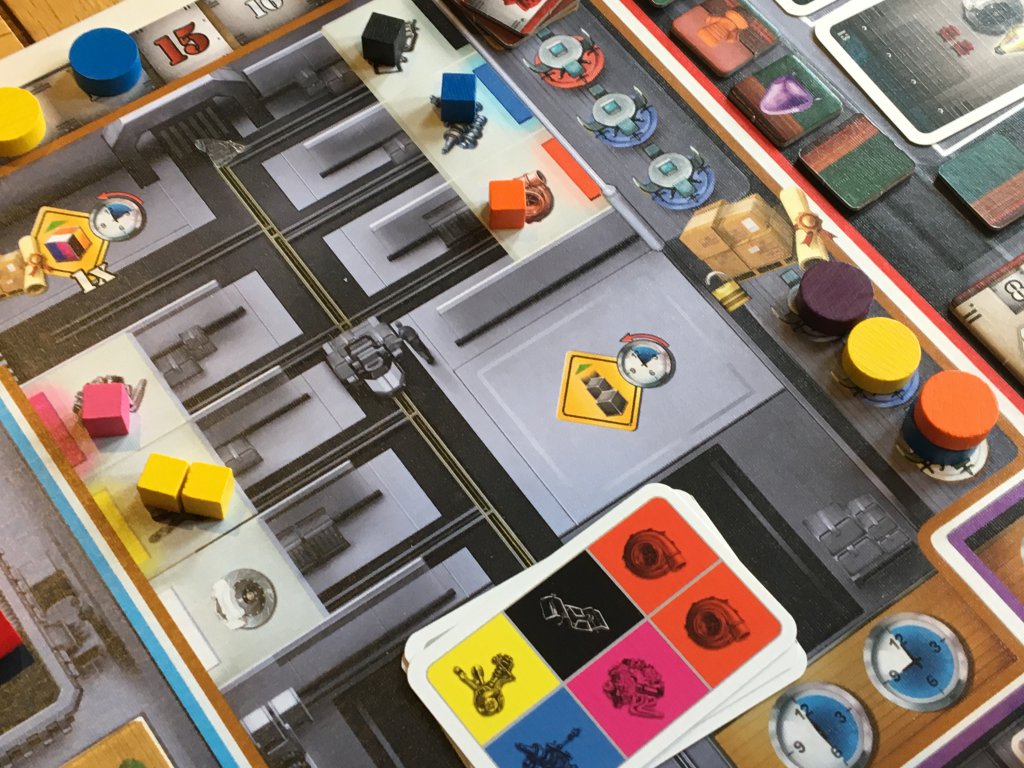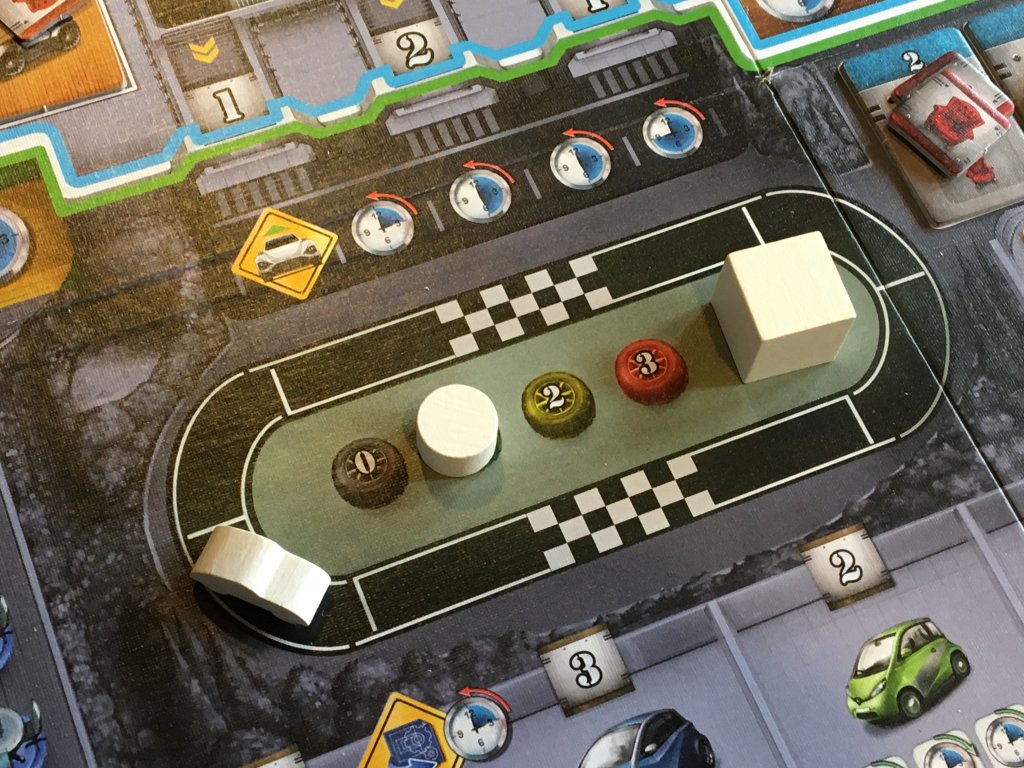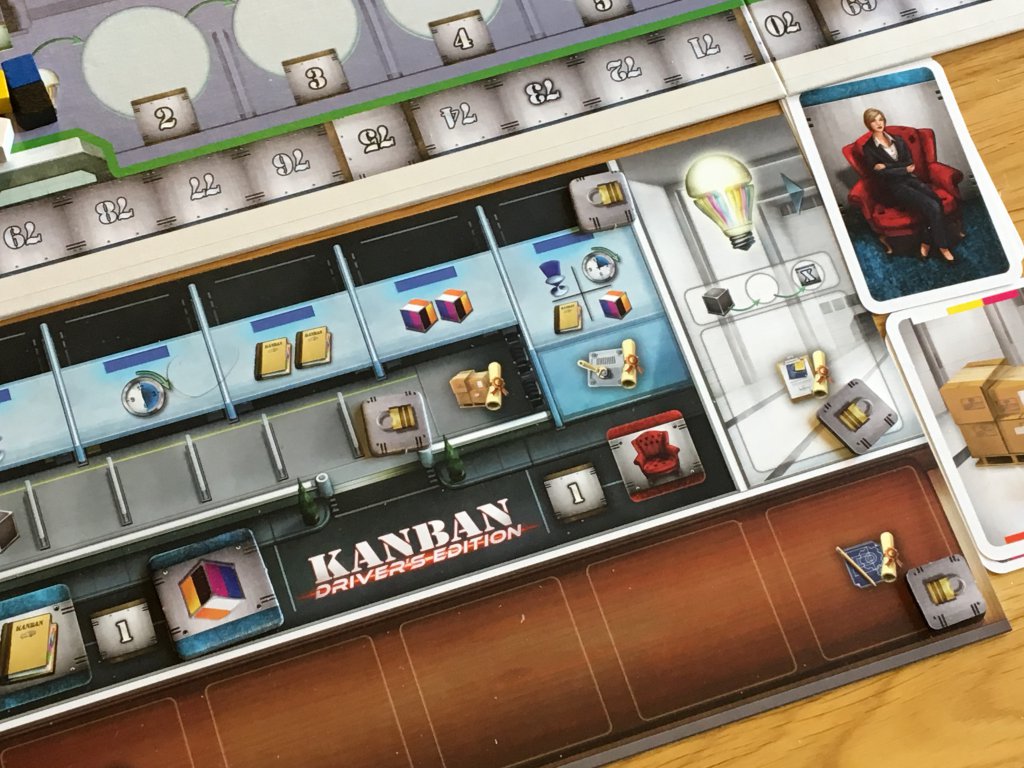The meaning of the word ‘Kanban’ originates from Japan and refers to a manufacturing system that uses clear and simple cue cards to drive factory workers to achieve maximum efficiency with minimal waste. In Vital Lacerda’s Kanban board game, one to four players compete to design, research and ultimately build the best motorcars using a single worker.
Like moist games from Vital Lacerda, Kanban is a relatively decision heavy game, but unusually for the designer who brought us Lisboa, Vinhos and the brand new Escape Plan; Kanban is remarkably simple to play. The players will be focussed on prestige points that represent their standing with the manager of the car factory, and whilst there are several ways to attain them, the decisions on a turn by turn basis are critical — there are actually very few to choose from.
Helping new players to understand Kanban is the logical flow of the board, which begins with the drawing board on the right hand side (where blueprints for the five kinds of cars on offer are collected) to the production line and test track (where cars are built and tested) on the left. In between, players will find the parts bin (where components can be collected) and the admin office, which allows the use of any area at an inefficient rate.
Whilst we’re on the subject of inefficiency, let’s talk about shifts. Kanban is a game about optimising your flow of work. Each of the factory departments has two locations, one of which allows two actions to be taken and one that allows three. Each of these actions is referred to as a shift, and if not used, spare shifts can be banked and then spent on later turns.
Assuming that neither space is in use by another player already, then a key factor in determining which space is best for you will come down to priority. Turns in Kanban are split into two main phases, with the players first assigning their single worker meeple and then taking the associated action in the next phase.
Both of these phases are resolved from left to right along the central track, department by department, so by taking the space with less shifts in any given location, the player will ensure that they always act first. The first space in each department generates two shifts, whilst the second generates three.
 As always with top tier worker placement games, turn order is of critical importance and it is most certainly worth acting first if you believe that one of your opponents is likely to take the other space. As an example, you may want to gain access to a specific blueprint, a set of parts, or to one or more of the cars on the production line.
As always with top tier worker placement games, turn order is of critical importance and it is most certainly worth acting first if you believe that one of your opponents is likely to take the other space. As an example, you may want to gain access to a specific blueprint, a set of parts, or to one or more of the cars on the production line.
As the players work their way through the factory taking the various (two to three) actions that come with each department, they are followed by a pink meeple that represents Sandra, the factory manager. Sandra assesses each location she visits, observing the experience level of each player (tracked alongside the department) providing either rewards or penalties depending on the mode of play.
This is decided at the beginning of the game by mutual agreement between the players, where a choice between kind Sandra and mean Sandra is made. In summary, kind Sandra will provide a prestige point reward to the player who is highest up the experience track, whilst mean Sandra will punish the player who is lowest.
There are several other factors to consider in Kanban, each of which is woven seamlessly into the basic flow. The game itself flows from the right side of the board to the left, and when sufficient cars have been added to the test track (and the pace car has moved around the track) a board meeting will be triggered. When this happens, the focus of play moves away from the factory and into a phase where each player attempts to impress Sandra.
This is done by spending seats (which thematically represent influence in the boardroom) on objective cards. There are four shared objectives that are displayed in the boardroom at all times, each of which can accommodate one or more seats — allowing players to score prestige points for achieving the overall goals of the factory.
Each player must also play one of their own objective cards (whether they can complete it or not) which may also allow the other players to complete it. Seats are earned during gameplay for achieving certain milestones, but they are relatively rare and cannot be spent frivolously. Each board meeting is a compelling mini-game in its own right and knowing how to maximimise your own score whilst limiting opportunity for your opponents is key.
 Board meetings bring another interesting nuance to play, in relation to those experience tracks that I mentioned. As players reach the halfway point on each track, they achieve a certification in that area — blueprint creation, logistics, production etc. Each time a certification is achieved, the player that obtains it is able to advance on yet another track, which represents their overall skill level and seniority within the factory. The more senior a player, the sooner they act in the board meeting.
Board meetings bring another interesting nuance to play, in relation to those experience tracks that I mentioned. As players reach the halfway point on each track, they achieve a certification in that area — blueprint creation, logistics, production etc. Each time a certification is achieved, the player that obtains it is able to advance on yet another track, which represents their overall skill level and seniority within the factory. The more senior a player, the sooner they act in the board meeting.
Kanban represents the very pinnacle of decision heavy board gaming, and the fact that it was designed by one of the industries most revered designers is plain to see. The theme is perfectly mated to the flow of the game, which in turn masterfully links each area within the factory to its neighbour, binding them all together with several tracks that just make sense.
The board meeting (which can occur up to three times per game) is undoubtedly the most exciting feature of the design, but it’s also so integral to the success or failure of the players that planning for it becomes a key part of everyday life within the factory phases. The fact that Sandra (in either mode) visits players in the factory frequently adds thematic and strategic spice that makes the experience all the sweeter.
The Drivers Edition of Kanban that we received for review comes with a double sided board (only the original side is pictured) and specifically shaped car meeples, but is otherwise identical to the original release. A deluxe edition is rumoured to be in production.
In truth, the version of Kanban I’ve been testing is a beautiful thing which comes with either the busy but attractive side you see in these pictures or a more muted, easier to understand alternative board. All components from the board to the manual are exceptionally well produced. The wooden components look great and I do like that the cars and people are shared appropriately, adding a bit of flair.
Overall, Kanban is a great game that is perfect for players who want to introduce players to the heavier end of board game decision making, without necessarily overwhelming them with periphery rules. Kanban’s base simplicity and flow is refreshing for a game of this weight, but the amount of planning that needs to go into each turn cannot be underestimated.
 With only one worker to control (and a working week over in perhaps two or three moves) the players need to make each and every decision count. Optimisation is key and wastage can be very costly. When endgame scoring rolls around, the number and type of cars produced, as well as the time invested in parts research can double a score easily, making the final outcome of each game hard to predict.
With only one worker to control (and a working week over in perhaps two or three moves) the players need to make each and every decision count. Optimisation is key and wastage can be very costly. When endgame scoring rolls around, the number and type of cars produced, as well as the time invested in parts research can double a score easily, making the final outcome of each game hard to predict.
Kanban is a hobbyists game that is clearly aimed at experienced board gamers, but among all of the Vital Lacerda games that I have played, it is by far the most accessible. It does have several rules and factors to consider, but compared to Lisboa, for example, it’s a walk in the park to learn and teach. Add to that beautiful components, a fantastic flow and genuine theme, and Kanban is certainly a modern classic.
Kanban is available for purchase now, including from Amazon. You can find out more about it on the Stronghold Games website.
Love board games? Check out our list of the top board games we’ve reviewed.


